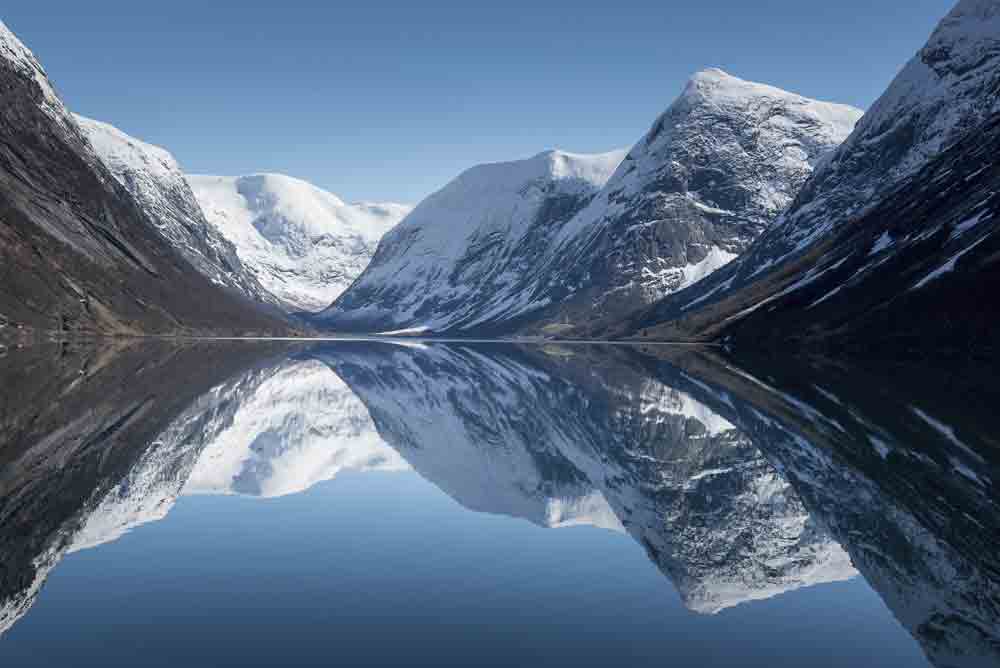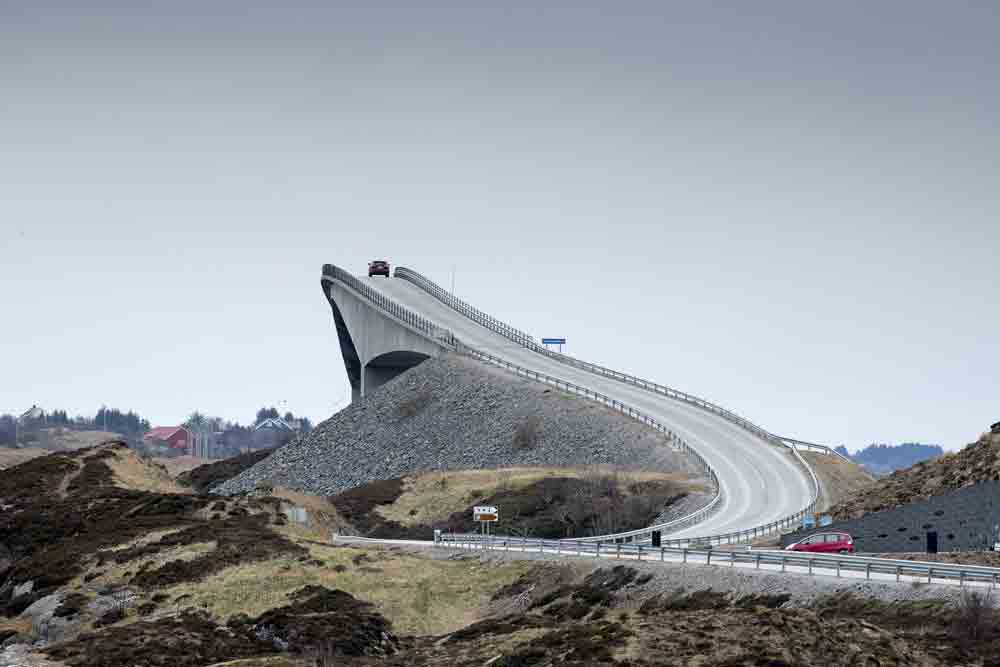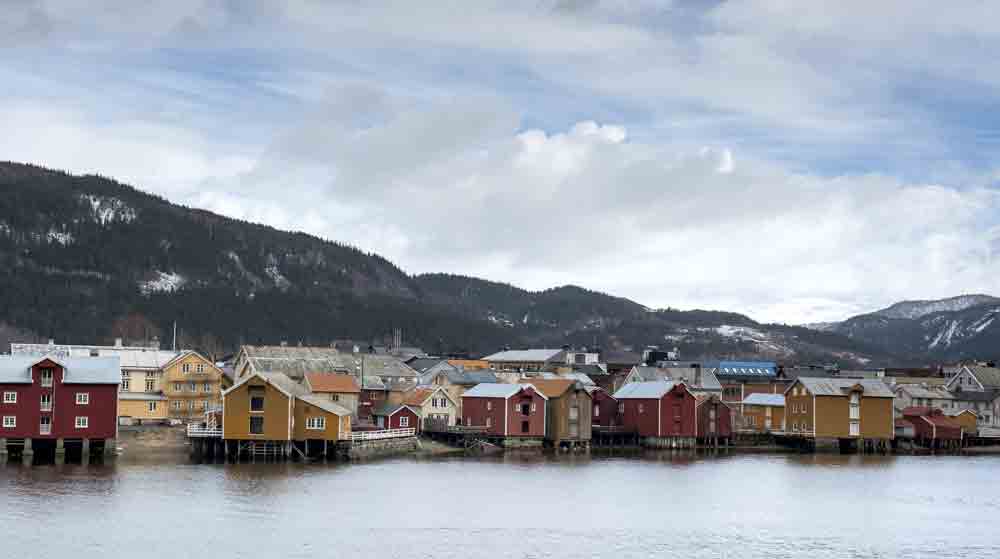Motorhome travel: Superb Scandinavia - it's motorhome-friendly Norway
Words and photos by Mike Waterman
I wonder what the weather is like in Norway in April?’ was the question I pondered in a warm, sunny, very spring-like southwest France.
Having wintered in the Aquitaine region, I was keen to get back on the road. Norway had been on my list of countries to visit ever since I had seen the distant, spectacular coast from the Denmark to Iceland ferry a couple of years previously.
Preparation was minimal. I registered online for the Norwegian tolls, which are all based on cameras and automated charging. Vehicle insurance was checked to see if Norway was covered and some quickly researched details of camping and waterfall locations were downloaded using WiFi at the local library.
Norway has a reputation for being expensive. I’d met a long-distance cyclist who had visited the country. She’d expected prices to be high, but had still been shocked at the reality of costs and had been forced to shorten her trip as the budget disappeared much faster than planned.
It worried me as that was the experience of a non-drinker. How bad would it be for a traveller who most definitely likes to finish a good day with a glass or two of whatever the locals prefer? I stocked up on tins and jars in a French supermarket and even found room for a few bottles of wine.
I left my base near Bordeaux on a late March morning and, after using motorways the whole 1,300 mile distance, arrived in Hirtshals on the north coast of Denmark two days later. To keep costs down, I had spent one night on a French aire and another in a Danish service station.
I checked into Hirtshals Camping; the site didn’t officially open for the season until the next day, but the owners were working on the premises and let me stay.
The Hirtshals to Langesund ferry (Fjord Line) was booked online for 9am the following morning.
I left a dull and wet Denmark on a ferry and four-and-a-half hours later arrived in sunny, but chilly, southern Norway. Customs clearance consisted of three questions: did I speak Norwegian or English, was I on holiday and where was I headed today?
My plan was to head up the western side of Norway. Almost immediately I came across quite a large lake, totally frozen over. Three days before I’d been in shorts and a t-shirt. Now it seemed that I had returned to winter!

Norway: very motorhome friendly
Norway is very motorhome friendly, with its bobilplassen (motorhome stopovers, which are often free). Many look a little like car parks, especially those in a town, but others are on harbours and marinas or in the countryside. Some have electricity for a fee and sometimes showers (usually for a fee) or a nearby toilet available. Most are detailed online and the key information is clear to a non-Norwegian speaker. GPS coordinates are usually provided.
On my first day in Norway, I headed to Båly Havn, near Lindesnes, on the coast between Kristiansand and Stavanger.
I arrived to find a marina complex and spotted four A-class Norwegian motorhomes huddled together at the end of a harbour wall in a gorgeous setting. Taking their lead, I parked up. The online information had promised my spot was free. There was a toilet at the marina buildings some 300m away, plus a shower, which could be paid for at the marina office.
My campervan has twin 88Ah batteries, an Eberspächer heater, chemical toilet and a small solar panel on the roof, so a night or two off-grid is to be welcomed in exchange for some free camping, especially in such a lovely location.
Norway has 18 national tourist routes (nasjonale turistveger) and marking them on my map with a highlighter pen suggested an obvious route north, simply by joining some of the routes together. That was as much planning as my route received.

As a thin and long country, broadly speaking, you head either up or down. This was especially so in April as I discovered many of the inland routes were still closed for winter, including the famous Trolls Ladder (Trollstigen) series of hairpin bends. At that time of the year coast equals passable routes and mountains equal closed roads.
My third day in Norway confirmed my fears about tolls. They are everywhere. My thought of taking back roads and avoiding them was not at all foolproof. The cameras are thick on the ground, especially in the south. A sign tells you the charge, but I soon gave up trying to keep tabs on what I’d spent. The individual amounts are small, yet the frequency is high.
At least the process is painless: you get an email giving the total monthly figure in sterling and a detailed breakdown of the individual tolls, complete with photos of your vehicle to prove the point. The bill is charged to the credit card specified when first registering.
I stayed in 31 different places in Norway - here I have selected the highlights.
Hiking at Preikestolen
Preikestolen Camping, east of Stavanger, is only two miles from the car park for the famous Pulpit Rock, where it cost NOK200 (£19.37) to park. One of the rangers told me that, during high season, they get between 8,000 to 9,000 visitors but, on the day of my visit, he estimated only 20 to 30.
It’s only a 4km (2½ miles) hike to this much-photographed spot but, mainly due to the weather, I found it tough. The trail marks were getting difficult to see in the mist and, when I got above the snow line, I missed a few of the markers. About 3km (1¾ miles) along it started to snow heavily and I really was losing the trail. I found the rock more through luck than judgement, took a hasty photo and retreated before my footprints – which were my only guide back – disappeared in the snow!
I used Preikestolen Camping as a base from which to see Jørpeland and the Jørpeland River Falls and to go even further north for the short hike to see the waterfalls at Sendingfossen and Hiafossen. These two waterfalls on the Storåna river are very close together on the same reasonably short walk. The car park (N59˚ 8’ 57” E6˚ 20’ 43”) feels in the middle of nowhere.
It’s a gentle climb walking upstream, although the path is quite rocky and can be slippery. Both falls are worth the effort on their own, but with two for the price of one and the benefit of downhill on the way back, the reward is high.
Heading towards Bergen, Sundal Camping is well worth a stay. Firstly, Furebergfossen is a short drive away and, secondly, it is also possible to walk from the site to the Bondhusvatnet (Lake Bondhus) and a remarkable view of the Bondhus Glacier. The glacier is, in fact, visible from the campsite.
Norway seems to have a very high level of motorhome ownership and they get used. I was there during a public holiday and was lucky to find a pitch although, after the two-day rush, the country was again mine.
Mosjøen looks just like a visitor would describe a Norwegian town, with multi-coloured, wooden buildings lining a fjord-based location. Mosjøen Camping is on the edge of the small town, conveniently close to a Rema 1000 supermarket.

A short walk allows exploration of the quaint streets, although I also crossed the bridge and took the wide footpath along the western shore of the Vefsnfjord, which gives lovely views of the town on the opposite bank of the fjord.
Exploring the Lofoten Islands
My home in Bodø was Bodøsjøen Camping. I was there for the ferry to Moskenes, which is at the western end of the Lofoten Islands.
If I had to pick one place in Norway, it would be this string of islands all joined together by a beautiful road, which is, unsurprisingly, a tourist route. The Lofoten Islands and I got off to a great start as, from my pitch in Moskenes Camping, I had the joy of watching a pod of orcas cruise by. Camping just doesn’t get better than that!
I’m not sure it’s possible to visit Norway and not want to get to Nordkapp, the most northerly point of mainland Europe. I was concerned about the roads, as it’s at 71 degrees north, nearly five degrees past the Arctic Circle. I took faith in the fact that Norwegians seem to be masters at clearing snow. When required, they regularly plough and spray the main routes.
I eventually arrived at Nordkapp on a late evening at the beginning of May. Twice a day you can wait at the end of the final road and a snowplough will provide an escort, but I was too late. The road had been ploughed, but the wind was drifting large volumes of snow. Walking round the cape was bitterly cold in the wind and the snow was up to a metre deep, but I think later in the year it might just have been another headland packed with tourists taking selfies.
I was there for an hour and hoped to camp in the car park. The only other tourist, a young German in his car, obviously had the same idea. It was a forlorn plan as, when the visitor centre closed, the three staff members came over and explained that no one could stay in winter and that they had called the snowplough to escort them (and us) back to the main road.
I stayed for free in considerably better weather in nearby Honningsvåg before heading back for a second visit to Nordkapp early the following morning.
Visiting Tromso
On the way south, Tromsø gave a good opportunity to restock as it’s the largest city in northern Norway. I stayed at Tromsø Camping, which is attached to a sports complex and an easy walk from the city centre.
On the way is the modern Arctic Cathedral, built in 1965. The Tromsø Bridge, which crosses the Tromsøysundet strait, has a pedestrian walkway which gives excellent views down to the Tromsø waterfront.
The third largest city in Norway, Trondheim is one of those places which is immediately recognisable, as images of the old quay are so often used to advertise both city and country.
The Trondheim Bobilparkering gives 24 hours of free parking, although there are no facilities provided. Getting a space in high season I suspect would be a real challenge. Located on the south bank of the Nidelva river, it’s a lovely walk along the river bank to the old town area.
I loved Norway in April, to the point where I stayed for half of May, too. The downsides at that time of year are that the ability to explore the inland mountains is severely restricted and the hiking is significantly limited.
Also, much of the free camping was unavailable, especially in the north, as it was covered in snow.
On the upside, there was a real sense of adventure about the trip. I felt like I had the place to myself and the Norwegian landscape is magnificent!
Trip summary
Motorhome: 2016 VW Transporter LWB with 2.0 litre diesel, converted by Camper King of Warwickshire
The costs
Fuel average 39mpg: £614
Ferries Denmark-Norway return, Bodo-Moskenes, 15 crossings in Norway: £349
Sites fees: £756
Tolls including the Atlantic Ocean Tunnel: £123
Total: £1,842
Travel: 4,519 miles
This travel feature was originally published in the April 2019 edition of MMM magazine - you can buy a digital version of that issue here.
If you enjoyed this feature, there are more travel articles - in the UK and Europe - each and every month in MMM. Click here to view print subscription prices.
You can view the details of the sites Mike stayed at here.








Recent Updates
Engine management lights: all you need to know
What is the engine management light? What does it mean, and what do I have to do? ...
Motorhome air suspension: all you need to know
Motorhomes are heavy and the additional weight of equipment and height of the bodywork can increase the loads ...
Motorhome WiFi: how to get better motorhome internet
Staying connected on the move is more and more essential, so relying on campsite WiFi isn't an option – here ...
A class of their own - our guide to A-class motorhomes
Thinking of trading up to an A-class, or even going straight to the top of the motorhome tree? We guide you ...
Explore overseas on a motorhome dream tour
Enjoy exotic travel in a campervan or motorhome by hiring, swapping with someone else or exporting your ...
Motorhome water systems: everything you need to know
On-board water is an important part of every motorhome – here’s everything you need to know ...
Campervanning in Europe: what you need to know
Whether you're planning a leisurely drive through the French countryside, navigating bustling city streets in ...
Campervan security: all you need to know
With thefts on the increase, it’s important to know how to keep your campervan secure and prevent campervan ...
Campervan furniture: everything you need to know
Our campervan experts guide you through all the essentials for your campervan, including tables, chairs, ...
Campervan finance: how to fund your purchase
Here we look at the different types of campervan finance available, to help you decide what’s the best option ...
Other Articles
Britain’s best used motorhomes
Want a great motorhome without paying the premium for a new one? Here's a guide to the best you can get in the pre-owned market for each layout, ...
Which motorhome? Choosing the perfect motorhome for you
Choosing a motorhome or campervan is one of the biggest buying decisions you’ll ever make, so it's important ...
Campervan washroom essentials: stay fresh on the road
Our guide will take you through the campervan washroom essentials you'll need so you're well-prepared for ...
Dogs in campervans: all you need to know
Follow our advice and your dog will enjoy campervanning as much as you do ...
Electric campervans: all you need to know
Our guide will take you through everything you need to know about electric campervans and what the future ...
Motorhome electrics: a complete guide to your motorhome electrical set-up
Motorhome electrics can dramatically enhance the convenience and comfort of your vehicle – but they can be ...
Lighting for campervans: all you need to know
We guide you through all the lighting options available for you and your campervan, including interior ...
Electric bikes for motorhomes: our ultimate guide
Read our comprehensive guide to electric bikes for motorhome owners, helping you add electric power to your ...
Our guide to 'cheap' motorhomes in 2024
If you're on the hunt for an affordable new motorhome, this is the best place to start – we've rounded up a ...
Campervans in winter: all you need to know
Here's your guide to preparing your campervan for the colder months, whether you will be using it or putting ...